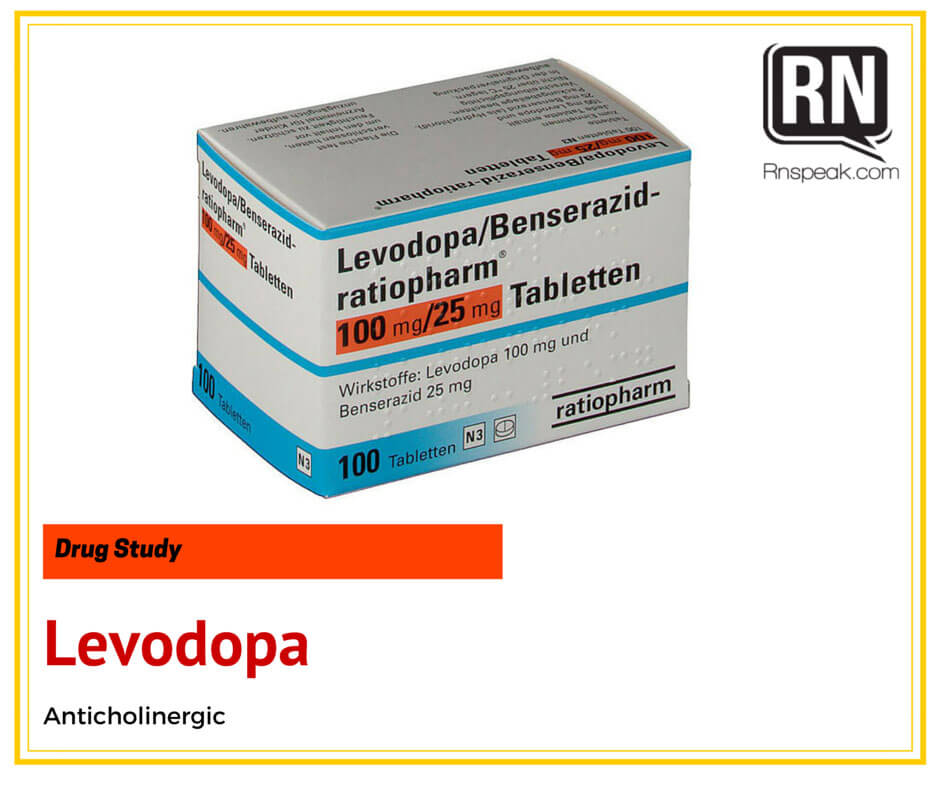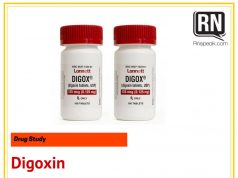
Generic Name: Levodopa
Brand Name: Dopar,Larodop
Classifications: autonomic nervous system agent; anticholinergic (parasympatholytic); antiparkinsonism agent
Pregnancy Category: C
Availability
100 mg, 250 mg, 500 mg tablets and capsules
Actions
Drug is a metabolic precursor of dopamine, a catecholamine neurotransmitter. Unlike dopamine, levodopa readily crosses the blood–brain barrier. Precise mechanism of action unknown.
Therapeutic effects
Levodopa restores dopamine levels in extrapyramidal centers (believed to be depleted in parkinsonism).
Uses
Idiopathic Parkinson’s disease, postencephalitic and arteriosclerotic parkinsonism, and parkinsonism symptoms associated with manganese and carbon monoxide poisoning.
Contraindicatons
Known hypersensitivity to levodopa; narrow-angle glaucoma patients with suspicious pigmented lesion or history of melanoma; acute psychoses, severe psychoneurosis, within 2 wk of use of MAO INHIBITORS. Safe use during pregnancy (category C), lactation, or in children <2 y is not established.
Cautious use
Cardiovascular, kidney, liver, or endocrine disease, history of MI with residual arrhythmias; peptic ulcer; convulsions: psychiatric disorders; chronic wide-angle glaucoma; diabetes; pulmonary diseases, bronchial asthma; patients receiving antihypertensive drugs.
Route & Dosage
Parkinson’s Disease
adult: PO 500 mg to 1 g daily in 2 or more equally divided doses, may be increased by 100–750 mg q3–7d (max: 8 g/d); used in combination with carbidopa, decrease levodopa dose by 75%–80%
Administration
Oral
- Give with food to reduce nausea. Absorption is decreased with high-protein meals.
- Crush tablets or empty capsule content into fruit juice as needed.
- Store in tight, light-resistant containers.
Adverse effects
CNS: Choreiform and involuntary movements, increased hand tremor, bradykinetic episodes (on–off phenomena), trismus, grinding of teeth (bruxism), ataxia, muscle twitching, numbness, weakness, fatigue, headache, opisthotonos, confusion, agitation, anxiety, euphoria, insomnia, nightmares; psychotic episodes with paranoid delusions or hallucinations, severe depression, including suicidal tendencies, hypomania.
CV: Orthostatic hypotension; palpitations, tachycardia, hypertension.
SpecSenses: Blepharospasm, diplopia, blurred vision, dilated pupils.
GI: Anorexia, nausea, vomiting, abdominal distress, flatulence, dry mouth, dysphagia, sialorrhea; burning sensation of tongue, bitter taste, diarrhea or constipation; GI bleeding, hepatotoxicity.
BodyWhole: Flushing, increased sweating, weight gain or loss, edema, dark sweat or urine.
Urogenital: Urinary retention or incontinence, increased sexual drive, priapism, postmenopausal bleeding.
Skin: Skin rashes, loss of hair.
Respiratory: Rhinorrhea, bizarre breathing patterns.
Nursing implications
Assessment & Drug Effects
- Monitor vital signs, particularly during period of dosage adjustment. Report alterations in BP, pulse, and respiratory rate and rhythm.
- Supervise ambulation as indicated. Orthostatic hypotension is usually asymptomatic, but some patients experience dizziness and syncope. Tolerance to this effect usually develops within a few months of therapy.
- Make accurate observations and report adverse reactions and therapeutic effects promptly. Rate of dosage increase is determined primarily by patient’s tolerance and response to drug.
- Monitor all patients closely for behavior changes.
- Monitor patients with chronic wide-angle glaucoma for changes in intraocular pressure.
- Monitor diabetics for loss of glycemic control.
- Lab tests: Monitor blood glucose & HbA1C, CBC, Hgb and Hct, serum potassium, and liver & kidney function periodically.
- Report promptly muscle twitching and spasmodic winking (blepharospasm); these are early signs of overdosage. Patients on full therapeutic doses for >1 y may develop such abnormal involuntary movements as well as jerky arm and leg movements. Symptoms tend to increase if dosage is not reduced.
- Report to physician any S&S of the on–off phenomenon sometimes associated with chronic management: Rapid unpredictable swings in intensity of motor symptoms of parkinsonism evidenced by increase in bradykinesia (attacks of “leg freezing” or slow body movement).
- Monitor mental status for S&S of drug-induced neuropsychiatric adverse reactions.
Patient & Family Education
- Do not take with high-protein foods. Also avoid high consumption of food sources of pyridoxine, including wheat germ, green vegetables, banana, whole-grain cereals, muscular and glandular meats (especially liver), legumes. Learn good dietary practices.
- Do not take OTC preparations or fortified cereals unless approved by physician. Multivitamins, antinauseants, and fortified cereals usually contain vitamin B6.
- Make positional changes slowly, particularly from lying to upright position, and dangle legs a few minutes before standing.
- Resume activities gradually, observing safety precautions to avoid injury. Elevation of mood and sense of well-being may precede objective improvement. Significant improvement usually occurs during second or third week of therapy, but may not occur for 6 mo or more in some patients.
- Follow prescribed drug regimen. Sudden withdrawal of medication can lead to parkinsonism crisis (with return of marked rigidity, akinesia, tremor, hyperpyrexia) or neuroleptic malignant syndrome (NMS).
- A metabolite of levodopa may cause urine to darken and sweat to be dark-colored.
- Do not breast feed while taking this drug without consulting physician.







